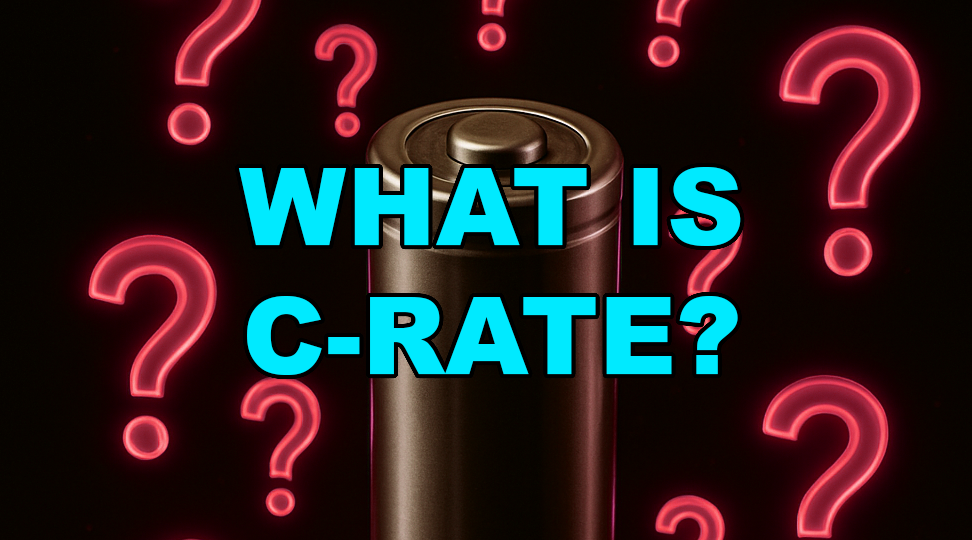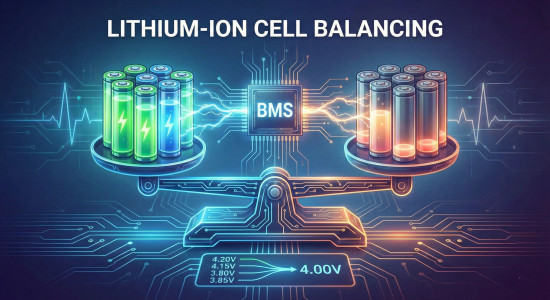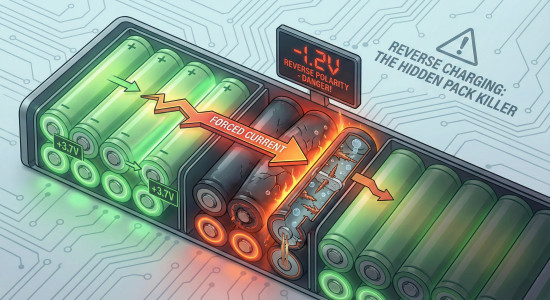
Lithium-Ion Battery C-Rate Explained: Charge & Discharge Limits, Heat, and Safety
Table of Contents
What is a lithium-ion C-rating? A C-rating tells you how fast the lithium-ion battery can be charged or discharged relative to its capacity.
Short note: Think of C-rate as “current relative to size.” The same C-rate means “equally hard use” only when you’re talking about very similar cells.
Quick C-Rate Examples
So if a battery has a 1 C charge rate and it is a 2.5 amp-hour battery, then you can charge that battery at 2.5 amps. If it has a half C charge rate, then you can charge that battery at 1.25 amps. If you have a 3 amp-hour cell and you discharge it at half a C, then you are discharging that cell at 1.5 amps of current. Or if you have a 2,200 milliamp-hour battery, which is 2.2 amp-hours, and you discharge it at 25 C, that would be 55 amps. And the 50 C burst would be 110 amps for a few seconds.
Short note: Manufacturers often publish separate continuous and burst C-ratings. Use the continuous rating for anything sustained; treat burst ratings as brief ceiling numbers.
Why C-Rate Is Used
But there are definitely some important things that you need to know. C-rate is used in an attempt to normalize stresses across different sizes. It essentially normalizes how hard you're pushing the cell. Here's the logic behind it. Capacity is amp-hours, so that's how much charge the cell can hold. Current is amps, which is how fast you can pull or push that charge. If you divide those, you get the C-rate. The reason this can be physically meaningful is for cells of similar designs in chemistry, the allowable current scales with capacity. So because you have more active material and more electrode area. So 2 C is roughly the same stress on a 500 milliamp-hour cell as it is on a 5 amp-hour cell, even though 2 C for the 500 milliamp-hour cell is 1 amp and 2 C for the 5 amp-hour cell is 10 amps. But this is only true if the cells are otherwise identical. So the same exact chemistry, the same proportions in the same package and format just scale differently. That's the only time you can use the C-rate to compare batteries like that.
Short note: C-rate is a handy shorthand inside a family of like-for-like cells. Once you change chemistry, construction, or format, the shorthand stops being reliable.
Thermals and Scaling
For similar cells, the thermals actually scale nicely. The internal heat is current squared times resistance, and resistance tends to drop as the cells get bigger. So it works out to be inverse with capacity. But that's only if they're the same exact design cell in the same kind of chemistry. In reality, cells have different designs and are going to have different resistances. So you can have two identical capacity cells; they're both 2,000 milliamp-hours, and you do 2 C on one of them and 2 C on the other, and one of them can get very hot and the other one could only get lukewarm. The one with the higher resistance is going to be the one that gets hotter.
Short note: In packs, contact resistance, wiring, and airflow can shift temperatures a lot, even if the cells themselves match on paper.
What C-Rate Ignores
While C-rate is a convenient normalization, it hides two big variables. It totally ignores internal resistance. Internal resistance causes heat loss inside of a cell with the formula of I squared times R. So if one cell is 30 milliamp and the other is 15 milliamp, they are going to be stressed different amounts for the same current. It also ignores the thermal pathway. So better can design, better tab design, and better cooling features will lower the temperature delta for the same amount of current.
Short note: Datasheets usually list internal resistance (often in milliohms) and sometimes thermal characteristics; those numbers are crucial for predicting heat rise.
Why C-Rate Is Still Used (and Where It Breaks)
So why is C-rate still used? Because it's easy, and it's a simple way to look at it, and it works good enough most of the time. For similar chemistries and constructions, resistance tends to scale down as the cells get bigger. So the same C often means similar stresses per watt-hour. But across different designs, high power versus high energy, or pouch versus 18650, different porosities and binders, there's so many variables that goes into this, that scaling will totally break.
Short note: Treat stated C-ratings as a convenient starting point, then verify with measurements in your actual use case.
When to Use C-Rating
So when is it the best time to use C rating? You can just treat C rating as a general starting point, not as a guarantee. You should really only use it when you're comparing the same exact type of batteries. The best thing to do is to measure the internal resistance or at least look it up in the data sheet. If they're brand-new cells, you can rely on that. And then you will know the performance of the cell and how many watts of heat it will dissipate at any current.
Short note: Remember that temperature, state of charge, and aging all increase effective resistance, which lowers the safe continuous C-rate over time.
Power Loss Example
You can see in this power loss chart here, comparing a 15 milliohm cell and a 30 milliohm cell from 0 to 50 amps. At 10 amps, we have just 1.5 watts of power loss with the 15 milliohm cell, but the 30 milliohm cell has 3 watts of power loss. That's double. And then at 20 amps, we have 6 watts of power loss for the 15 milliohm cell. And what do you know? Double that, 12 watts of power loss in the 30 milliohm cell. And you can see it scales all the way up. For each amp of flowing current, you are going to have double the amount of heat.
So you can see the power loss scales linearly. At 40 amps, the 15 milliohm cell dissipates 24 watts, and the 30 milliohm cell dissipates 48 watts. It's exactly double going one way and exactly half going the other. But look at the current scale. Look left to right instead of top to bottom. For the 15 milliohm cell, we have 1.5 watts at 10 amps and then 6 watts at 20 amps. So it's adding 4.5 watts for every 10 amps. So it seems, but if you go up another 10 amps to 30 amps, you'll see that much more than 4.5 watts was added.
And then go up another 10 amps, and you can see how it increases more and more. So with a fixed resistance, as you increase the current, the heat output increases exponentially. But with a fixed current, as you increase resistance, the heat output increases linearly.
Short note: Small increases in current can drive disproportionately higher heat, so leave generous thermal margin and validate with real measurements.


